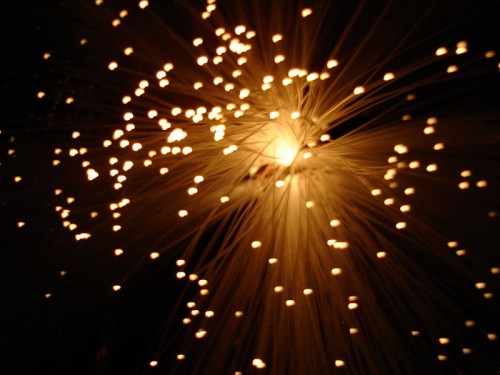Better Living through Zinc Selenide: Making More Efficient Optical Fibers
Worried that I would become the recipient of incessant emails extolling the merit of elegant crystal decanters and pithy advice on how to choose the perfect shrimp fork, I decided to give out my fifteen-year old aol email address (which I have pretty much completely surrendered to spam bots). Typing “aol.com” in my browser to complete verification took me back to the days of dial-up modems. Remember the hauntingly beautiful series of sounds that indicated you were about to engage with the Internet? “eeeeeeeeeeeaaaahhhhwwwwwww eeeeeeeeaahahhhhhhhhwwwwww eeeeeeeeeeahhhhhhhhhwww uhuhuhuhuhhhhhhh tttttttttt ‘you’ve got mail!'” Remember how it took forty five minutes to check your email?
These days, most of our information travels at insane rates of speed along optical fibers only three times as thick as human hair. Current fiber optics “transmit over a terabyte – the equivalent of 250 DVDs – of information per second” (Physorg.com). That seems like an awful lot of data in a very short amount of time, but just think about what we’d get up to if we could transmit even more!
Image credit Pineda Zuniga
Our current optical fibers are limited by their glass cores. The problem is that atoms in glass are arranged rather haphazardly, and the material by and large is not a semiconductor. Researchers at Penn State led by John Badding suspected that a crystalline substance – specifically, zinc selenide – is a semiconductor capable of allowing light to be transported over longer wavelengths (i.e. mid-infrared) because the atoms in crystals are orderly and organized. The team used an innovative high-pressure chemical-deposition technique to deposite zinc selenide waveguiding cores inside of silica glass capillaries to form a brand new class of optical fibers (Physorg.com).
Image credit wikimedia commons
The new optical fibers were more efficient at converting light from one color to another, and they provided more versatility not just in the visible spectrum, but also in the infrared – electromagnetic radiation with wavelengths longer than those of visible light. This is a very cool development because it may represent a step towards making fibers that can act as infrared lasers (good for military applications and corrective eye surgery) and because the technology may also allow us to detect pollutants and environmental toxins more easily (Physorg.com). The idea is that we could transport light over long wavelengths through the atosphere, looking for substances that absorb the long wavelength light. Better fiber optics means richer, faster, and more accurate transmission of information, and that is exciting, don’t you think? It might be even more exciting than hearing “you’ve got mail!”
I have filed this new development under FIRE because fiber optics transmit information with light.
Cited:
“New Kind of Optical Fiber Developed.” Physorg.com. 02/25/11. Accessed 02/28/11. URL.


















Leave a Wordpress Comment: